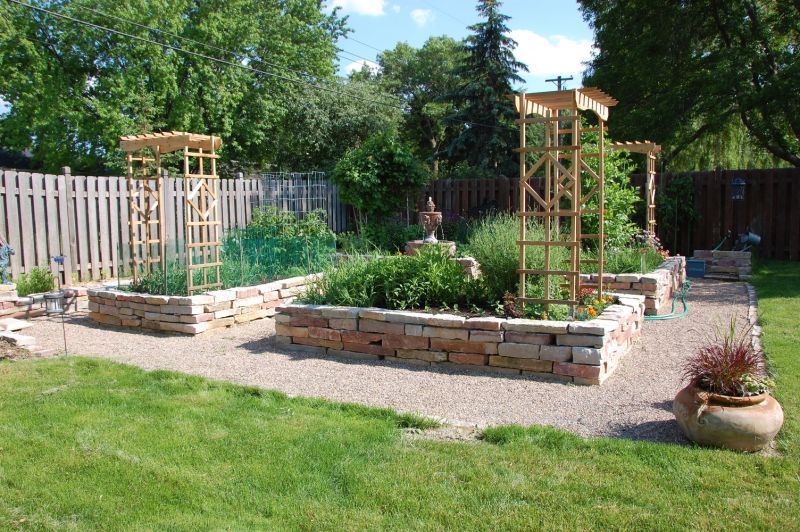Mountain gardeners use raised beds to sidestep a long list of gardening challenges. Bad dirt is out, because you fill a raised bed with a customized soil-and-compost blend. Drainage is built in and keeps erosion in check. Greater exposure to the sun warms the bed, which allows more plant diversity and extends the growing season. Plants can be spaced closer together, so yields go up, water use efficiency is maximized and weeds are crowded out. Beyond the ease is the control, as you grow your favorite vegetables and flowers, you feed and soak your plants with just what they need for optimum growth. 
A raised bed is most productive and attractive as a bottomless frame set into a shallow trench. The sides can be almost any durable building material, including rock, brick, concrete and interlocking blocks. Watering troughs or clawfoot tubs can work, as long as they have the capacity and drainage.
Location, Location, Location – at minimum build 3 x 6 foot beds. This size is wide enough to support sprawling tomatoes, but narrow enough to reach easily from both sides. The ideal height is 1 to 2 foot tall. Do NOT fill the bed with dirt from the garden. Instead, fill a mix of peat moss, compost, soil-less potting soil or growers mix into planters. Use a 2 x 4 to level the soil, then plant. If possible, build more than one bed, which makes it easier to rotate crops and meet the watering needs of specific plants.
Finding a flat spot spares a lot of digging; walls should definitely be level when complete. Ideally, a north-to-south orientation takes full advantage of available light. Avoid sites shaded by the house or under messy trees. Leave at least 18 inches between beds for walkways, or 2 ft if you need room for a wheelbarrow or lawnmower.
Planning & Building – To prepare the site, get rid of turf and weeds. Outline the bed dimensions on the ground with chalk-line, string or a spare hose. Dig just deep enough to bury about half of your first course of lumber or block. If there is no turf between your beds, put down some landscape fabric and cover it with pavers or a layer of gravel to improve drainage. After running out in the rain for a fresh bell pepper, you will appreciate the mud free shoes.
Level the earth or gravel layer at the bottom of the bed, then put down a layer of weed suppressing landscape fabric that extends to the outer edge of the wooden frame. Now is also the time to think about pest control. The rich soil in a raised bed has worms and other delicacies that attract gophers, while voles relish young veggie roots. To keep out burrowing pests I recommend a bottom layer of hardware cloth, a mesh grid of steel or galvanized metal 1” or less in diameter should do the trick.
Good Soil is Key – For small beds use bagged Potting Soil designed specifically for our arid climate. A good local soil holds moisture, yet drains fast enough to allow deeper root growth. Blend “Tomato & Vegetable Food 4-4-6” and Gypsum into the top layers of the soil and you are ready to plant lettuce, spinach, potato, horseradish and onions at first sign of a spring thaw. That will happen the first few days of March.
Reduce Water Needs – “Aqua Boost Cystals” are a water holding polymer infused with  seven different mycorrhizal fungi. The crystals absorb water and keep it at the plants roots while the mycorrhizal fungi animates soil to the point plants are exited to root faster and deeper into you soil. If you have had trouble with watering issues in the past, try it. Eventhing I plant gets a hearty dose of Aqua Boost as they are planted, especially raised beds and container gardens.
seven different mycorrhizal fungi. The crystals absorb water and keep it at the plants roots while the mycorrhizal fungi animates soil to the point plants are exited to root faster and deeper into you soil. If you have had trouble with watering issues in the past, try it. Eventhing I plant gets a hearty dose of Aqua Boost as they are planted, especially raised beds and container gardens.
Plant of the Week – Blue berry bushes thrive in raised beds. Sunshine Blue Blueberry is a semi-dwarf selection and perfect for smaller raised gardens or large patio pots. Blue-green foliage and showy hot pink to white flowers provide great ornamental value, followed by an abundant crop of great tasting fruit only enjoyed from a blueberry bush. Best of all this new blue variety is self fruitful, so it only takes one bush to tango. Who wants to dance now?
Garden Class – Designer Rich Olson was such a big hit during the design class I’ve invited him back to teach next Saturdays “Best Practices for Raised Bed Gardening” class. The free class will be held on February 23 starting at 9:30. Rich is a real professional and a wealth of proper design knowledge. Class will be held in the back greenhouses at Watters Garden Center.
Until next week, I’ll see you at the garden center.


…you’d better home that Popular Mechanics doesn’t find out you plagiarized their material!
http://www.popularmechanics.com/home/how-to-plans/lawn-garden/4308264#slide-1